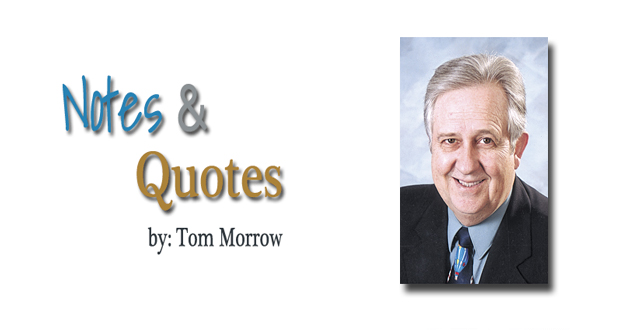The Many Cruises of the ‘USS Bonhomme Richard’
By Tom Morrow
A weird, but historic name for a United States Naval vessel is “The Bonhomme Richard.” Five ships of the USS Navy line were designated to be named “Bonhomme Richard,” translated in French: “Good Man Richard.”
The name is in reference to American Founding Father Benjamin Franklin, who wrote and published Poor Richard’s Almanac in the early days of the Revolution. Founder of the Navy, Capt. John Paul Jones, named the first Bonhomme Richard in honor of Franklin, who had persuaded the French king to give the new ship to our fledgling nation. The actual first ship of the Navy was “The Ranger,” but Jones lost her during an early battle to the British. It was aboard that ship when Jones yelled to the British captain: “I have not yet begun to fight!”
The first Bonhomme Richard was put into service by Jones in 1779, then 85 years later, in 1864, the second Bon Homme Richard was to be constructed at the Washington D.C. Navy Yard, but was canceled at the end of the Civil War.
In 1937, the to-be named USS Bonhomme Richard (CV-5) was the first aircraft carrier. Despite the damage suffered during an earlier battle in late May 1942, Yorktown(CV-5) was able to return to Pearl Harbor for repairs. Although estimates were the damage would take two weeks to repair.
Yorktown put to sea only 48 hours after entering drydock and was available for the pivotal Battle of Midway. Yorktown’s aircraft played crucial roles in sinking two Japanese fleet carriers. Yorktown also absorbed both Japanese aerial counterattacks at Midway which otherwise would have been directed at the carriers USS Enterprise and Hornet. On June 4 during the Battle of Midway, Japanese aircraft crippled the Yorktown. She lost all power and developed a 23-degree list to port. Salvage efforts on Yorktown were encouraging, and she was taken in tow by USS Vireo. In the late afternoon of June 6, a salvo of torpedoes, two struck Yorktown, and a third sunk the destroyer USS Hammann which had been providing auxiliary power. With further salvage efforts deemed hopeless, the remaining repair crews were evacuated from Yorktown, which sank on the morning of June 7. In May 1998, the wreck of Yorktown (CV-5) was located by famed marine archeologist Robert Ballard, who earlier had found the HMS Titanic in the Atlantic.
In honor of the Yorktown lost at Midway, prior to its launch, the newest Bonhomme Richard again lost the name, and at launch was christened “Yorktown (CV-10).
During WWII, together with the carrier USS Lexington, the Yorktown (CV-10) successfully attacked Japanese shipping off the east coast of New Guinea in early March 1942. Her aircraft sunk or damaged several warships supporting the invasion of Tulagi in early May. Yorktown rendezvoused with Lexington and attempted to stop the invasion of Port Moresby, New Guinea. They sank the Japanese light aircraft carrier Shoho on May 7, 1942, during the Battle of the Coral Sea, but did not encounter the main Japanese force of the Japanese carriers until the next
day. Aircraft from Lexington and Yorktown badly damaged a Japanese aircraft carrier.
During the War, USS Bon Homme Richard (CV-31), an Essex-class aircraft carrier, was the first Navy ship to keep the name since the Revolutionary War. It saw action at the end of World War II, during the Korean War, and throughout the Vietnam War.
Decommissioned shortly after the end of World War II, The Bonhomme Richard CV-31, one of 24 aircarriers built during the War, was modernized and recommissioned in February 1953, as an attack carrier (CVA), and served with distinction. The ship was later modernized again with a slanted deck, eventually becoming an antisubmarine carrier (CVS) and served for many years in the Pacific, including duty in the Vietnam War. Later, the carrier served as a recovery ship for the Apollo 8 space mission, and was used in the film “Tora! Tora! Tora!” which recreated the Japanese attack on Pearl Harbor, and in the science fiction film “The Philadelphia Experiment.”
Although the Navy’s upper echelon dislikes the moniker, the crews of the two Bonhomme Richards affectionally referred to their ship as “The Bonnie Dick.”
The latest Bonhomme Richard
Today, the latest USS Bonhomme Richard (LHD-6), is a San Diego-based Wasp-class amphibious assault ship recently severely damaged by
fire. The Navy presently is contemplating whether or not to restore her to service or scuttle.
The USS Yorktown (CV-10) was decommissioned in 1970 and in 1975 became a museum ship at Patriots Point, Mount Pleasant, South Carolina, where she was designated a National Historic Landmark.
Although the “Bonhomme Richard” has taken a backseat name-wise to three ships, today’s ship (maybe) will continue flying the colors of the nation.
In a post-script, when in Annapolis, Md., stop by the U.S. Naval Academy and visit John Paul Jones’ tomb, an impressive monument to the first Bonhomme Richard captain.




